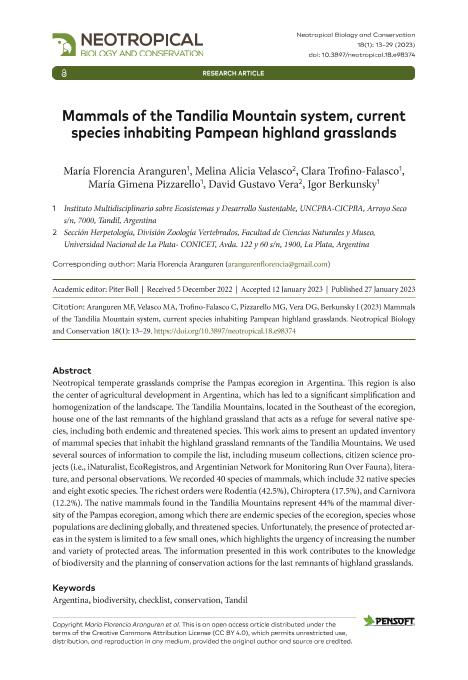Mostrar el registro sencillo del ítem
dc.contributor.author
Aranguren, Maria Florencia

dc.contributor.author
Velasco, Melina Alicia

dc.contributor.author
Trofino Falasco, Clara

dc.contributor.author
Pizzarello, María Gimena

dc.contributor.author
Vera, David Gustavo

dc.contributor.author
Berkunsky, Igor

dc.date.available
2024-01-10T13:14:13Z
dc.date.issued
2023-01
dc.identifier.citation
Aranguren, Maria Florencia; Velasco, Melina Alicia; Trofino Falasco, Clara; Pizzarello, María Gimena; Vera, David Gustavo; et al.; Mammals of the Tandilia Mountain system, current species inhabiting Pampean highland grasslands; Pensoft Publishers; Neotropical Biology and Conservation; 18; 1; 1-2023; 13-29
dc.identifier.issn
2236-3777
dc.identifier.uri
http://hdl.handle.net/11336/223175
dc.description.abstract
Neotropical temperate grasslands comprise the Pampas ecoregion in Argentina. This region is also the center of agricultural development in Argentina, which has led to a significant simplification and homogenization of the landscape. The Tandilia Mountains, located in the Southeast of the ecoregion, house one of the last remnants of the highland grassland that acts as a refuge for several native spe-cies, including both endemic and threatened species. This work aims to present an updated inventory of mammal species that inhabit the highland grassland remnants of the Tandilia Mountains. We used several sources of information to compile the list, including museum collections, citizen science pro-jects (i.e., iNaturalist, EcoRegistros, and Argentinian Network for Monitoring Run Over Fauna), litera-ture, and personal observations. We recorded 40 species of mammals, which include 32 native species and eight exotic species. The richest orders were Rodentia (42.5%), Chiroptera (17.5%), and Carnivora (12.2%). The native mammals found in the Tandilia Mountains represent 44% of the mammal diversity of the Pampas ecoregion, among which there are endemic species of the ecoregion, species whose populations are declining globally, and threatened species. Unfortunately, the presence of protected areas in the system is limited to a few small ones, which highlights the urgency of increasing the number and variety of protected areas. The information presented in this work contributes to the knowledge of biodiversity and the planning of conservation actions for the last remnants of highland grasslands.
dc.format
application/pdf
dc.language.iso
eng
dc.publisher
Pensoft Publishers

dc.rights
info:eu-repo/semantics/openAccess
dc.rights.uri
https://creativecommons.org/licenses/by/2.5/ar/
dc.subject
ARGENTINA
dc.subject
BIODIVERSITY
dc.subject
CHECKLIST
dc.subject
CONSERVATION
dc.subject
TANDIL
dc.subject.classification
Zoología, Ornitología, Entomología, Etología

dc.subject.classification
Ciencias Biológicas

dc.subject.classification
CIENCIAS NATURALES Y EXACTAS

dc.title
Mammals of the Tandilia Mountain system, current species inhabiting Pampean highland grasslands
dc.type
info:eu-repo/semantics/article
dc.type
info:ar-repo/semantics/artículo
dc.type
info:eu-repo/semantics/publishedVersion
dc.date.updated
2024-01-09T15:05:49Z
dc.journal.volume
18
dc.journal.number
1
dc.journal.pagination
13-29
dc.journal.pais
Bulgaria

dc.journal.ciudad
Sofia
dc.description.fil
Fil: Aranguren, Maria Florencia. Consejo Nacional de Investigaciones Científicas y Técnicas. Centro Científico Tecnológico Conicet - Tandil; Argentina. Universidad Nacional del Centro de la Provincia de Buenos Aires. Facultad de Ciencias Exactas. Instituto Multidisciplinario de Ecosistemas y Desarrollo Sustentable; Argentina
dc.description.fil
Fil: Velasco, Melina Alicia. Consejo Nacional de Investigaciones Científicas y Técnicas. Centro Científico Tecnológico Conicet - La Plata; Argentina. Universidad Nacional de La Plata. Facultad de Ciencias Naturales y Museo. División Zoología de Vertebrados. Sección Herpetología; Argentina
dc.description.fil
Fil: Trofino Falasco, Clara. Consejo Nacional de Investigaciones Científicas y Técnicas. Centro Científico Tecnológico Conicet - Tandil; Argentina. Universidad Nacional del Centro de la Provincia de Buenos Aires. Facultad de Ciencias Exactas. Instituto Multidisciplinario de Ecosistemas y Desarrollo Sustentable; Argentina
dc.description.fil
Fil: Pizzarello, María Gimena. Consejo Nacional de Investigaciones Científicas y Técnicas. Centro Científico Tecnológico Conicet - Tandil; Argentina. Universidad Nacional del Centro de la Provincia de Buenos Aires. Facultad de Ciencias Exactas. Instituto Multidisciplinario de Ecosistemas y Desarrollo Sustentable; Argentina
dc.description.fil
Fil: Vera, David Gustavo. Consejo Nacional de Investigaciones Científicas y Técnicas. Centro Científico Tecnológico Conicet - La Plata; Argentina. Universidad Nacional de La Plata. Facultad de Ciencias Naturales y Museo. División Zoología de Vertebrados. Sección Herpetología; Argentina
dc.description.fil
Fil: Berkunsky, Igor. Consejo Nacional de Investigaciones Científicas y Técnicas. Centro Científico Tecnológico Conicet - Tandil; Argentina. Universidad Nacional del Centro de la Provincia de Buenos Aires. Facultad de Ciencias Exactas. Instituto Multidisciplinario de Ecosistemas y Desarrollo Sustentable; Argentina
dc.journal.title
Neotropical Biology and Conservation
dc.relation.alternativeid
info:eu-repo/semantics/altIdentifier/url/https://neotropical.pensoft.net/article/98374/
dc.relation.alternativeid
info:eu-repo/semantics/altIdentifier/doi/http://dx.doi.org/10.3897/neotropical.18.e98374
Archivos asociados
